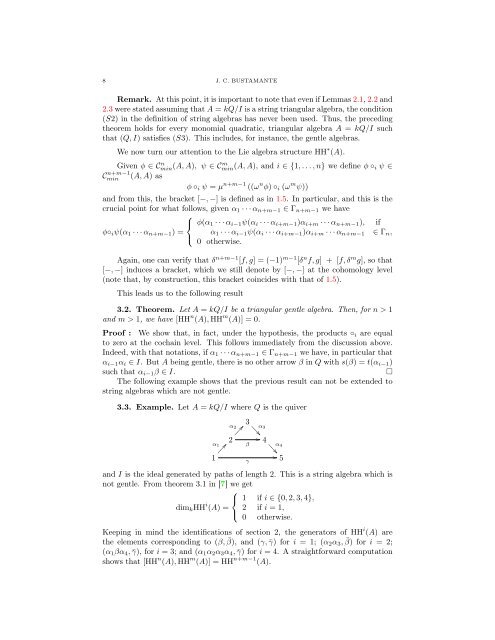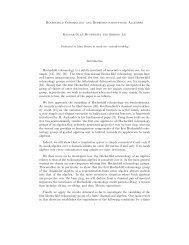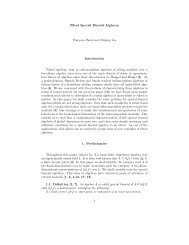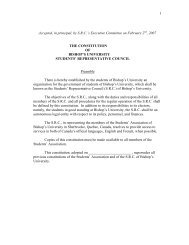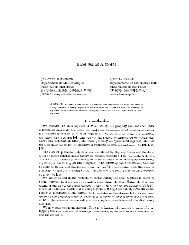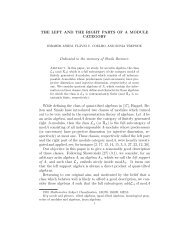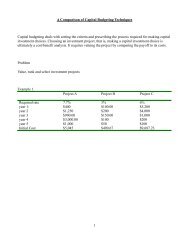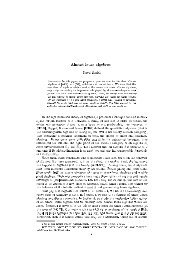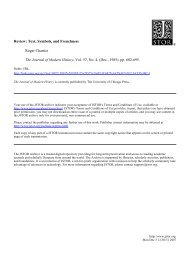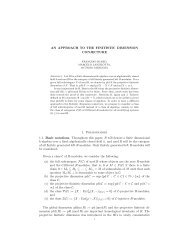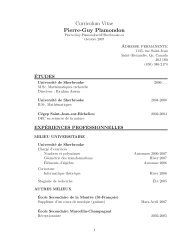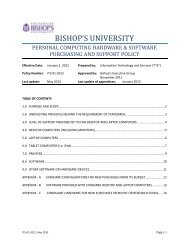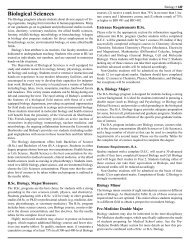The cohomology structure of string algebras
The cohomology structure of string algebras
The cohomology structure of string algebras
Create successful ePaper yourself
Turn your PDF publications into a flip-book with our unique Google optimized e-Paper software.
8 J. C. BUSTAMANTE<br />
Remark. At this point, it is important to note that even if Lemmas 2.1, 2.2 and<br />
2.3 were stated assuming that A = kQ/I is a <strong>string</strong> triangular algebra, the condition<br />
(S2) in the definition <strong>of</strong> <strong>string</strong> <strong>algebras</strong> has never been used. Thus, the preceding<br />
theorem holds for every monomial quadratic, triangular algebra A = kQ/I such<br />
that (Q, I) satisfies (S3). This includes, for instance, the gentle <strong>algebras</strong>.<br />
We now turn our attention to the Lie algebra <strong>structure</strong> HH ∗ (A).<br />
Given φ ∈ Cmin n (A, A), ψ ∈ Cm min (A, A), and i ∈ {1, . . . , n} we define φ ◦ i ψ ∈<br />
(A, A) as<br />
φ ◦ i ψ = µ n+m−1 ((ω n φ) ◦ i (ω m ψ))<br />
C n+m−1<br />
min<br />
and from this, the bracket [−, −] is defined as in 1.5. In particular, and this is the<br />
crucial point for what follows, given α 1 · · · α n+m−1 ∈ Γ n+m−1 we have<br />
⎧<br />
⎨ φ(α 1 · · · α i−1 ψ(α i · · · α i+m−1 )α i+m · · · α n+m−1 ), if<br />
φ◦ i ψ(α 1 · · · α n+m−1 ) = α 1 · · · α i−1 ψ(α i · · · α i+m−1 )α i+m · · · α n+m−1 ∈ Γ n ,<br />
⎩<br />
0 otherwise.<br />
Again, one can verify that δ n+m−1 [f, g] = (−1) m−1 [δ n f, g] + [f, δ m g], so that<br />
[−, −] induces a bracket, which we still denote by [−, −] at the <strong>cohomology</strong> level<br />
(note that, by construction, this bracket coincides with that <strong>of</strong> 1.5).<br />
This leads us to the following result<br />
3.2. <strong>The</strong>orem. Let A = kQ/I be a triangular gentle algebra. <strong>The</strong>n, for n > 1<br />
and m > 1, we have [HH n (A), HH m (A)] = 0.<br />
Pro<strong>of</strong> : We show that, in fact, under the hypothesis, the products ◦ i are equal<br />
to zero at the cochain level. This follows immediately from the discussion above.<br />
Indeed, with that notations, if α 1 · · · α n+m−1 ∈ Γ n+m−1 we have, in particular that<br />
α i−1 α i ∈ I. But A being gentle, there is no other arrow β in Q with s(β) = t(α i−1 )<br />
such that α i−1 β ∈ I.<br />
□<br />
<strong>The</strong> following example shows that the previous result can not be extended to<br />
<strong>string</strong> <strong>algebras</strong> which are not gentle.<br />
3.3. Example. Let A = kQ/I where Q is the quiver<br />
3<br />
α 2<br />
<br />
2<br />
α 1 β<br />
<br />
1<br />
γ<br />
α 3<br />
4<br />
α 4<br />
5<br />
and I is the ideal generated by paths <strong>of</strong> length 2. This is a <strong>string</strong> algebra which is<br />
not gentle. From theorem 3.1 in [7] we get<br />
⎧<br />
⎨ 1 if i ∈ {0, 2, 3, 4},<br />
dim k HH i (A) = 2 if i = 1,<br />
⎩<br />
0 otherwise.<br />
Keeping in mind the identifications <strong>of</strong> section 2, the generators <strong>of</strong> HH i (A) are<br />
the elements corresponding to (β, ¯β), and (γ, ¯γ) for i = 1; (α 2 α 3 , ¯β) for i = 2;<br />
(α 1 βα 4 , ¯γ), for i = 3; and (α 1 α 2 α 3 α 4 , ¯γ) for i = 4. A straightforward computation<br />
shows that [HH n (A), HH m (A)] = HH n+m−1 (A).


